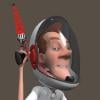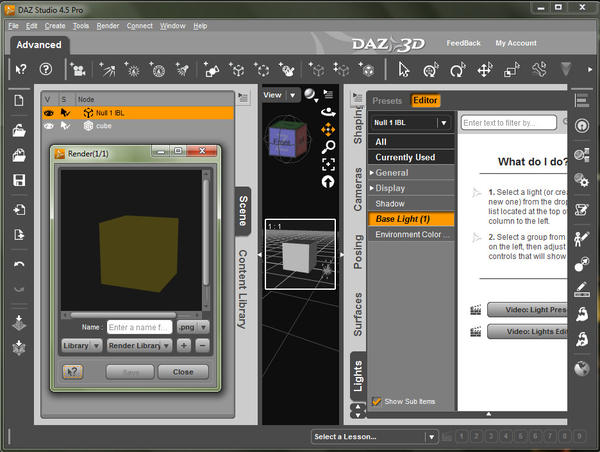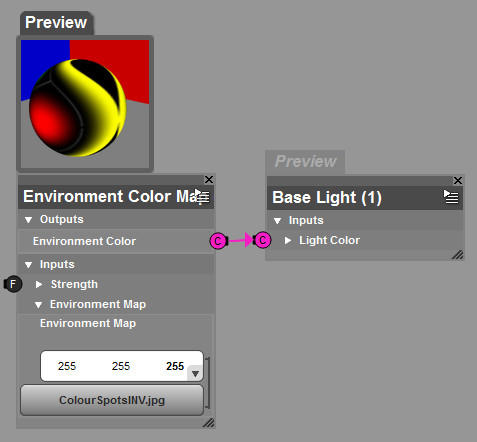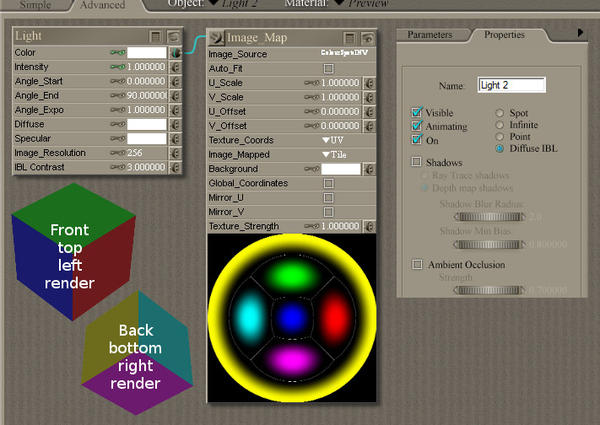Shader Mixer (DS3+4): How to make a very basic diffuse IBL? [ShaderBUILDER solution found?]
 3dcheapskate
Posts: 2,719
3dcheapskate
Posts: 2,719
{Edit: Possible Shader BUILDER solution in post 18 }
I want to make a very basic IBL light similar to Poser's diffuse IBL. (See first image - Poser 6, plain white cube lit by a single Diffuse IBL).
It should be simple since I'm not concerned with shadows, AO or anything like that at present. But I've Googled the DAZ forums, searched through the Shader Mixer Recipes threads , checked the documentation, etc, and I can't even find the basics! (I'm sure the answer's in the recipe threads somewhere though...)
So without anything to guide me I've been playing around and getting nowhere. I'm obviously doing something very wrong, probably right at the start... (See second image - a 'Light' shader with a 'Base Light' root brick [seems logical] and an 'Environment Color Map' [need some way to apply the IBL light probe angular map to the light])
Obviously this doesn't work (See third image - nice flat khaki colour for the cube)
Question 1: Can somebody put me on the right path please? I obviously need to create a 'Light' shader, so...
1a) I obviously need a root lighting brick. The 'Area Light' can't be added to a 'Light' shader, so the 'Base Light' seems the next most logical. Or not?
1b) I obviously need a brick that I can plug my IBL light probe image into. An 'Environment Color Map' seemed logical (although it clearly doesn't take an IBL light probe)
1c) I almost certainly need to add some other stuff in between. But what?
Question 2: When you've finished your 'Light' shader and you click 'Create', why does it create a Null, not a Light? What do I have to do to make a 'Light' Shader into an actual light in the scene?
(P.S. I know I could just use the UberEnvironment2 - but that's not going to help me actually understand how to create my own light shaders)








Comments
I do not think it matters; lights are not "real" objects anyway. You can simply give it a different name when creating it.
Thanks millighost - that's cleared up a lot of things for me. I added the Variable and NTransform bricks as you suggested and my DIY IBL is now casting light - a big step forward!
Time to do a bit more experimentation now.
I thought light probes were angular maps (and stated it here)? And I know that mirrorballs aren't angular maps. So are light probes the same as mirror balls then?
That isn't an IBL, from what I can tell it looks like it's projecting the environment map into the reflection channel, on every object in the scene that's using the default surface shader, use HSS or USS or any other shader and it renders black.
Bej that is what interior HDRI's can look like. ;) But good HDRI won't be jpeg, yes you can use LDRI such as jpeg but for me what they put out isn't worth using them.
Let's put it this way Pete, I was using an exterior long/lat that 3dcheapskate posted in the freestuff, I spent a couple of hours last night playing with it in UE2 and got some very good results from it, yet when I plug it into that network I get the attached result, not much use for an IBL but it has some use as a chrome.
Sorry bej you loast me. I was just refering to what you said about the OP's image no being an IBL. Image based Lighting can use any thing, with in reason but vary due to the quality fo the IBL map.
I thought light probes were angular maps (and stated it here)? And I know that mirrorballs aren't angular maps. So are light probes the same as mirror balls then?
I think "mirror ball" and "light probe" mean the same thing more often than not, because they are often used to refer to the object that is being photographed (like in "drill a hole into your light probe, so you can mount it on a tripod"). But it would probably be best not to call it "light probe" to avoid confusion. "Angular maps" in CG practically always refer to a specific mapping, but outside of CG, a "longitude/latitude map" is also called an "angular map". So basically you have three different names you can spread more or less arbitrarily on three different objects without being completely wrong. Many people on the internet make heavy use of that feature :-)
That is probably right (at least it renders black with the USS2). This is due to the fact that USS2 does not work with ambient at all, or at least i have found out how to make it work; the USS2's parameters named "ambient something" have nothing to do with ambient light, they simply seem to add a constant value to the color (which BTW makes it very similar to Poser's ambient setting which also is not influenced by lights, perhaps that is the idea behind it).
Okay, so I spent a bit of time experimenting. I was getting some effects that took a little while to figure out - see attached images.
-The UberEnvironment2 image render is correct, i.e. it's more-or-less identical to my Poser 6 render).
- At first glance the DIY IBL render (using millighosts shader network) looks completely wrong. But I managed to work out the explanation(s) for several of the issues render myself (and millighost's latest post seems to confirm them):
- The DIY IBL is effectively adjusting the ambient colour of every object in the scene, but is not touching the ambient strength. This makes perfect sense to me, and seems a completely logical way to apply a basic global light. But it's clearly not the way Poser does it.
- The lower sphere/cube/torus are solid black because they have ambient strength set to zero. (The upper ones have ambient strength=100%)
- The black text on white for the backdrop becomes coloured because the backdrop has diffuse/specular strength=0%, while ambient strength=100%, and ambient colour=white. (I specifically set it like this in Poser to stop the Diffuse IBL from having any effect on the backdrop!)
- The orientation of the colours is wrong, but MilliGhost already said this would happen in point 4 of the first reply.
- The appearance of the IBL-image on the objects looks more like a reflection than lighting (as Bejaymac pointed out), but this is because there is no automatic blurring applied to the light, as MilliGhost already said in point 3 of the first reply.
But there's two things I can't explain:
1) I'm not sure why the text on the background (which is mapped onto the inside of a large sphere using a lat/long mapping) appears to be blue - unless it's being illuminated from outside the sphere?
2) The front and left of the upper sphere, torus, and cube are the same colours (cyan and yellow respectively) - so why is the top of the cube imagenta, while the top of the sphere and torus are green?
I'm not too bothered with the HDR side of things yet, not until I better understand creating my own light shaders. But I've already got a provisional (although untested) method of creating true HDR light probes from Terragen Scenes, based on various things I've read (I've added a note about it to the post I think Bejaymac was talking about here).
Curiously, using the UberEnvironmet2 incorrectly got me exactly the results I'm trying to achieve. I'd actually deleted the UberEnvironment2 'Sphere' node, leaving just the UberEnvironment2 light node. Hopefully the attached composite screenshot makes it clear how I got what I got - test images from my other thread here http://www.daz3d.com/forums/discussion/20395/#299337
So if I could work out how to do this in Shader Mixer....
Just so you know the UE2 sphere does nothing but give you a visual reference for rotation and it has no bearing on the light output at all.
Thanks Szark, that's what I'd originally thought, and on a further check it's obviously correct - if I simply load the UberEnvironment2, set the Environment Mode to 'Ambient (No Ray-Tracing)', delete the EnvironmentSphere child node, apply one of the 'Set HDR xyz.dsa' presets to the UE2, and render I get what appears to be the correct lighting. If I apply a different 'Set HDR xyz.dsa' preset and render then the lighting changes appropriately in the render.
What confused me (or, to be honest, one of the many things that confused me...) is that if I look on the 'Lights' tab for the UE2 nothing has changed. Specifically there's no image applied to the Light > Basic > Color channel (which seemed to me to be the obvious place to apply the light probe).
So I then applied my ColourSpots angular map to the Light > Basic > Color channel (the 'incorrect' way to use the UE2 I assumed, since none of the 'Set HDR xyz.dsa' presets touch this channel) and I was surprised that this gave me the results I'm after.
Millighost's simple light shader network has given me a starting point, but it's giving distinctly different results from the Poser Diffuse IBL without AO (which is what I'm trying to mimic). And more importantly I (sort-of) understand why the results are different.
So I'm still trying to create a DS light shader that has a similar effect to the Poser Diffuse IBL without AO. Still experimenting based on millighost's initial response, which gave me the pointers I asked for. But I may need more pointers soon...
;-)
This actually seems to be a bug. It happens for the flat faces, where the normal points exactly up or exactly down. For the longitude/latitude mapping, the longitude and latitude are not clearly defined at the north and south pole, which results somehow in the wrong mapping. I do not know if internally a flipped normal is generated or a texture coordinate outside outside the 0-1 range (which would result in wraparound in the texture). It can be fixed by adding a small offset to the normal when it is pointing in the positive or negative y-direction. Also, the environment map brick (as opposed to the environment color map brick) seems to work a bit better. It does not happen in with 3delight's built in environment() map at all, so i think the brick must be doing something slightly different.
Seeing your side by side comparison renders has reminded me that the environment bricks in the SM have never "worked right", they have always "rotated" the image differently to everything else in the scene, it was first noticed in DS 3.0, when people imported a surface into SM to connect the tiling brick to Bump and the like, on applying back to the surface they noticed their reflection maps were not showing the same as they were before importing.
Someone at DAZ wrote a recipe to fix this, can't remember if it was only available in the bug report or if was made available in the old forums too, I grouped it and saved it as a custom brick in DS3, I'll copy it over to DS4 and see if it still works.
EDIT
The attached pic show the differences
1 = texture applied to diffuse
2 = texture applied to reflection, diffuse strength set to 0%
3 = environment color map plugged into diffuse
4 = the DAZ fix applied to diffuse
As you can see from 1 & 3 there is a quite a difference, the map has been rotated a good 90 degrees, while 2 & 4 are identical, so apparently that's how environment maps are meant to look.
Thanks for the replies!
millighost:
- Re the top of the cube being magenta: I'd never have worked that one out! Yep, an x/z rotation of about 0.09° or more and it goes green as it should.
- Re the all-encompassing sphere being illuminated from outside: that surprises me. It's not a Sphere primitive, it's an imported OBJ with only internal faces, so the normals should all be inwards facing. I'm aware that if you import a one-sided plane OBJ (4 vertices, 1 face) into DAZ Studio it'll be visible from both sides (unlike Poser), but I wouldn't expect it to flip the normals?
Bejaymac:
- I guess it should be possible to correct the azimuth by adjusting the normal before plugging it into the Environment Color Map brick? (If it's a multiple of 90 degrees and I have the normals in world space, then simply splitting the normal with an XYZ Components brick, swapping/inverting X and/or Z as appropriate, and then recombining with a Point brick should do the trick, and could also handle any left/right flip of the image by inverting X or Z. Or not, but it's worth a play!)
- Regarding image 4 - are you* saying that's how an environment map applied to diffuse should look?
*or DAZ, or whoever it was at DAZ who wrote the fix
Anyway, back to my simplistic experimenting. After a quick download and read of RiSpec 3.2.1 (well I've only actually skimmed through pages 120-122...) and a brief foray into ShaderBuilder (which is beginning to make a vague sort of sense now...) I'm back playing with ShaderMixer.
And back to the very, very basics - trying to work out how to get a light shader that only affects the DAZ surface diffuse colour, and not the DAZ surface ambient colour.
My test subjects this time are 3 DS sphere primitives with a red-white-and-black checker image applied to ambient colour only. The only differences between the spheres are the diffuse/ambient strength.
I then created three ShaderMixer lights and did a render with each light. Each light is a single lighting root brick - all I changed was setting the light colour to green.
1. Just a 'Distant Light' root brick
2. Just a 'Base Light' root brick
3. Just an 'AreaLight' root brick applied to a long thin cylinder
Results in the attached image reminded me of these two comments: way back in the second post...
Looking at the results I assume that the Base Light must be non-directional. The Distant Light is clearly directional - so if I took that and if (instead of doing whatever jiggery-pokery it does with surface-normal and light-direction) I just plugged surface-normal into an Environment Color Map and used the light colour from that, then Bob's your Uncle!
But I'm beginning to think that what I want may not be easy (possible?) in Shader Mixer - maybe I need to dive into Shader Builder?
Well, I think I've got what I wanted using ShaderBuilder in DS3. Ridiculously simple really - almost embarrassingly so! It's just a point light whose position is defined by the point on the surface being illuminated - i.e. the point light is at the end of the surface normal.
Started with the DzPointLight network, disconnected the shadow stuff, adjusted a few connections, added an Environment macro and a couple of user inputs and it worked first time! Screenshot of the bits that are doing things attached. Also a DS3 render (similar setup to the 3 spheres in the previous post). Of course I need to do a bit more testing and make sure it's really working as a want...
If that goes okay I'll maybe try to do the same in ShaderMixer.
I fear it will not work in shader mixer, because it is missing the Illuminate function. Perhaps you can make a custom brick in shader builder and import it into shader mixer. I have read somewhere that this is possible (but i did not try it myself).
I fear it will not work in shader mixer, because it is missing the Illuminate function. Perhaps you can make a custom brick in shader builder and import it into shader mixer. I have read somewhere that this is possible (but i did not try it myself).
Yep, a custom brick might be the way to go for ShaderMixer (have to do some reading up). But I've done a bit more testing with the ShaderBuilder light from my previous post, and I'm fairly sure that it does what I want (attached test renders) - so I'm wondering is there any point trying to do it in Shader Mixer too?
I think the Shader Builder network needs a bit of tweaking so...
...A Couple Of Shader BUILDER Queries
1) The unnecessary parameters from the 'User Parameters' macro appear on the DS parameters tab, and I want to stop that. ButI can't delete the parameters I don't want (i.e. shadow stuff) from the 'User Parameters' macro since the 'Delete' option is greyed out (even after disconnecting them from everything). I can't replace the 'User Parameters' macro or delete the old one, or add a new one. And if I create a new SB light shader from scratch it gives me a predefined 'User Parameters' block with parameters I can't delete
2) With no Environmental map the light colour is black. I think I can fix this with a conditional 'if (no EnvMap) then (use just light color)
3) I have to give my light a 180 deg Y rotation and a -90 deg X rotation to get it oriented to match my background. Should be able to adjust the Ns before plugging it into the Environment macro.
Edit: 4) A more general observation - I think the effect of the environmental IBL should be a lot more subtle. Basically greyish light with just a hint of colour? So maybe ((color x intensity) x environment color) isn't the right mix? Time for a bit more experimenting...
(Just in case you hadn't noticed, I've changed my display name from 3dcheapskate to unrealimperfect - just trying it out... it's already had me confused, so I added a note to my siggy too!)
Been doing a lttle side-by-side-comparison of this DIY DAZ Studio ShaderBuilder Diffuse IBL against the Poser version and it's looking reasonably good. Basic test scene is P6 Jessi, three primitives, a DIY terrain, a DIY all-encompassing background sphere (background image from here), a distant light for casting the shadows, and a diffuse IBL. For the DAZ Studio renders I imported the PZ3 I'd used in Poser and replaced the Diffuse IBL with my DIY DS SB version.
I'm fairly sure that most of the differences can be fixed by tweaking settings, e.g. to get the relative intensities of the two different lights nicely balanced. But there are two things I hadn't spotted/thought of before:
...carrying on the numbering from the last post for the ShaderBUILDER queries...
5) The DIY DS SB version is creating specular highlights (you can see them on the sphere and torus in the bottom-right render) - it shouldn't, so I need to work out how to prevent this.
6) The DIY DS SB version shows up as a point light in the preview (that'll be because I created it from a DzPointLight SB macro). It would be nice if I could find a way to change this, but it's a rather minor issue.
I fear it will not work in shader mixer, because it is missing the Illuminate function. Perhaps you can make a custom brick in shader builder and import it into shader mixer. I have read somewhere that this is possible (but i did not try it myself).
nothing of my shaders in shader builder with illuminance block works in shader mixer. Probably I'm very wrong, but I believed Iluminate was in shader mixer before.